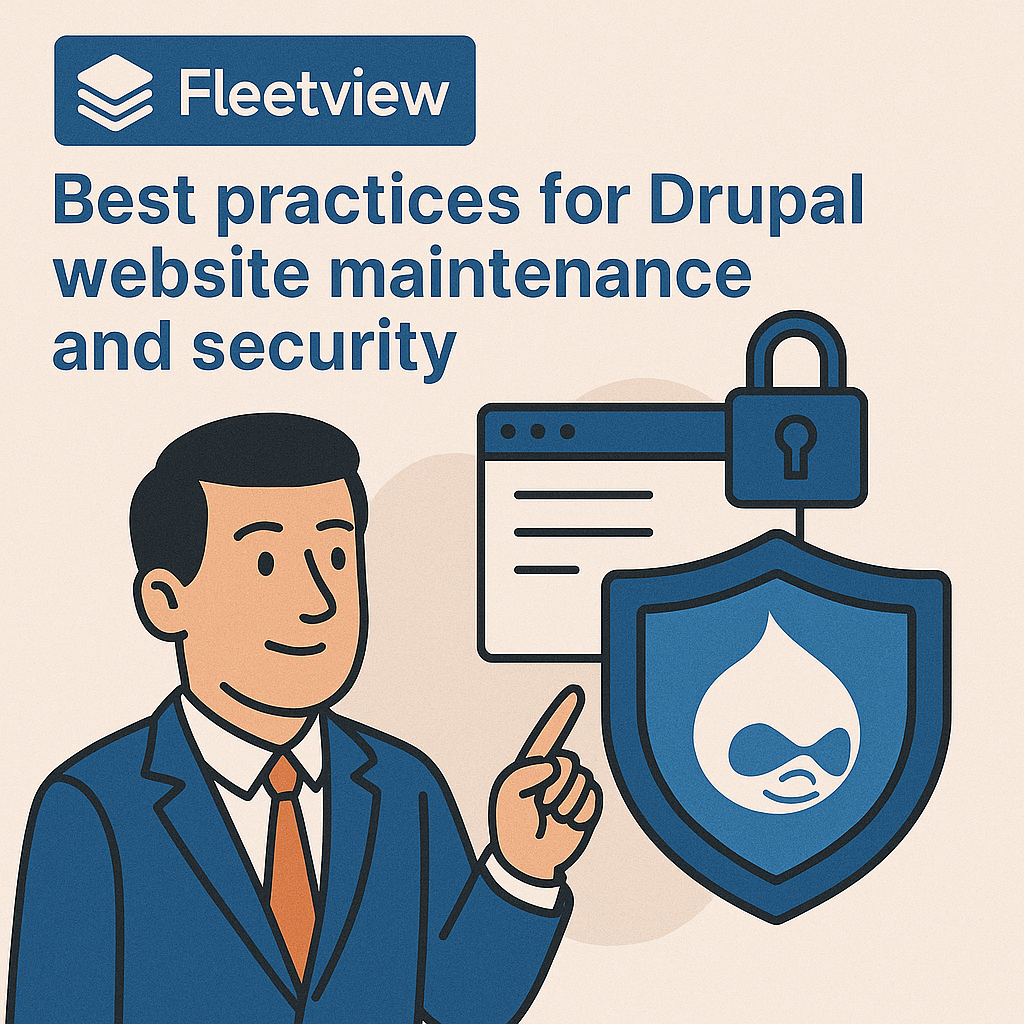Best Practices for Drupal Website Maintenance and Security

Introduction
Maintaining a Drupal website isn’t a one-time task - it’s an ongoing commitment to performance, security, and reliability. Whether you manage one Drupal site or a fleet of them, following proven best practices helps you reduce downtime, strengthen security, and ensure your clients’ digital assets are well cared for.
In this guide, we’ll walk through essential Drupal website maintenance and security practices. Plus, we’ll show how Fleetview supports agencies and site owners in staying on top of everything, with real-time updates, monitoring, and actionable insights.
1. Keep Drupal Core and Modules Updated
Drupal releases frequent updates to fix bugs and patch vulnerabilities. Outdated modules and core versions are a major security risk.
- Subscribe to Drupal security advisories.
- Use Composer to keep dependencies under control.
- Regularly check for available updates via the admin UI or CLI.
Fleetview helps by notifying you of available updates across all your client sites in one place.
2. Schedule Regular Backups
Backups are your safety net. Ensure that both your codebase and database are backed up on a consistent schedule.
- Automate backups via hosting provider or cron jobs.
- Test backups regularly for data integrity.
- Store backups offsite in case of server failure.
3. Monitor Website Uptime and Performance
Unexpected downtime or slow page loads can lead to lost traffic and frustrated users.
- Use uptime monitoring tools to track site availability.
- Benchmark performance with tools like Lighthouse or New Relic.
- Set alerts for outages or performance dips.
Fleetview includes uptime and status monitoring for every site in your dashboard, so you're never in the dark.
4. Harden Drupal Security
Security best practices protect against malicious attacks, unauthorized access, and data breaches.
- Enforce strong password policies and 2FA for admin users.
- Limit user roles and permissions to the principle of least privilege.
- Avoid assigning the Administrator role - unless absolutely necessary - developers can login using Drush. Project managers should use the client's role.
- Secure configuration files and ensure the site is served over HTTPS.
- Run the
drush security:reviewcommand regularly.
5. Encrypt User Data Where Appropriate
For sites collecting sensitive user information via forms, it’s critical to encrypt the data at rest.
- Use the
encryptmodule in combination with a secure encryption key storage method (such as Key module with AWS KMS or HashiCorp Vault). - Integrate
webform_encryptto encrypt Webform submissions, protecting user data submitted through forms. - Never store sensitive data like passwords, national IDs, or card details in plain text.
6. Conduct Penetration Testing for Critical Projects
For enterprise and mission-critical websites, a professional penetration test can reveal vulnerabilities that automated tools miss.
- Consider hiring a qualified security firm to perform regular penetration testing.
- Focus on both infrastructure and application-level vulnerabilities.
- Follow up with remediation actions and retesting as needed.
7. Use Strong and Unique Database Credentials
Database access is a common attack vector. Weak or reused passwords can lead to full compromise.
- Use a unique, complex password for each environment (development, staging, production).
- Store credentials securely (e.g., outside the webroot or using an environment variable system).
- Restrict database access to localhost or trusted IP addresses only.
8. Follow Drupal Coding Standards and Secure Practices
Writing secure code is fundamental to Drupal site safety. Badly written custom code can introduce vulnerabilities.
- Always follow Drupal's official coding standards.
- Never use raw SQL unless absolutely necessary – use the database API or entity queries.
- Validate and sanitize all user inputs. Never trust GET/POST parameters.
- Avoid insecure functions like
eval()andexec()in custom modules. - Perform code reviews, especially for custom or third-party integrations.
- Check for common vulnerabilities like XSS, CSRF, and SQL injection.
9. Audit Logs and Site Activity
Monitoring who does what on your site helps catch potential threats early and ensures accountability.
- Enable and review Drupal’s log reports (Recent log messages, Watchdog, Syslog).
- Track admin logins and configuration changes.
10. Clean Up Unused Code and Modules
Extra modules and themes can introduce bloat and security holes.
- Audit your installed modules twice a year.
- Uninstall anything not actively used.
- Avoid deprecated or unmaintained contrib modules.
11. Use Version Control and Staging Environments
Never make changes directly on live. Use Git and a staging workflow to test before you deploy.
- Store your codebase in a Git repository (GitHub, GitLab, Bitbucket).
- Use CI/CD pipelines for testing and deployment.
- Test updates and new features in a staging environment before pushing to production.
12. Use a Centralized Monitoring Dashboard
If you're managing multiple Drupal websites, it’s easy to lose track of what needs attention. A unified dashboard helps you stay organized.
Fleetview is built for this. It gives you:
- Real-time module and core update status
- Uptime and SSL certificate monitoring
- Server cost tracking and performance metrics
- Project-specific documentation, notes, and tasks
Conclusion
Proper Drupal maintenance and security is more than just ticking boxes - it’s about creating a process you can trust. By implementing the best practices outlined here, agencies can ensure their clients’ sites are stable, secure, and always performing at their best.
With Fleetview, you gain visibility and control across your entire Drupal ecosystem - making maintenance easier, faster, and more proactive.